The Ultimate Guide To LinkedIn B2B Marketing: Tactics And Insights That Work
- GUIDES
Mastering LinkedIn B2B marketing is crucial for reaching professional audiences effectively.
In this article, learn to navigate LinkedIn’s unique environment with strategies that drive real business results—target your market more precisely, build impactful relationships, and generate leads with agility.
In A Nutshell
Leverage LinkedIn’s targeted B2B tools like Sponsored Content and InMail, and engage with decision-makers by demonstrating thought leadership and creating meaningful connections.
Optimise your LinkedIn Company Page with a compelling company description, consistent visual branding and a strong call-to-action to drive conversions and distinguish your brand.
Implement an engaging content strategy with a mix of media formats and a consistent posting schedule to establish your brand as an industry leader and facilitate lead generation through LinkedIn’s unique tools.
The Power of LinkedIn for B2B Marketing

LinkedIn has revolutionised the landscape of B2B marketing with its suite of tools designed to target ideal audiences, enhance brand visibility, and generate leads.
Unlike other social media platforms, LinkedIn’s user base primarily consists of professionals and decision-makers across various industries, making it a unique and potent platform for B2B marketing.
The platform’s advertising tools, including Sponsored Content and InMail, are designed to facilitate precise targeting and communication with specific audience segments using tailored content.
LinkedIn offers excellent networking features and a variety of content formats that create opportunities to connect with decision-makers, engage with potential clients, and demonstrate thought leadership.
The cherry on top? LinkedIn is responsible for a whopping 97% of a business’s social media leads, underscoring its importance in B2B lead generation.
The Professional User Base
LinkedIn’s user base is a gold mine for B2B marketers. It predominantly consists of professionals and decision-makers, providing a unique advantage for B2B marketing.
Just imagine - with 80% of LinkedIn members in a decision-making role, the platform is teeming with potential B2B clients.
LinkedIn enables connections with CEOs, CMOs, and other senior executives, offering invaluable insights into the needs and challenges faced by decision-makers in the B2B industry.
This access to the right audience on LinkedIn puts B2B marketers in the driver’s seat, allowing them to tailor their messaging and offerings to resonate with potential clients.
Targeted Advertising Options
In a world where personalisation is key, LinkedIn’s advertising tools stand out.
With services like Sponsored Content and InMail, you can target your ads with surgical precision.
These tools offer over 20 different audience attribute categories, including location, job title, and interests, allowing you to reach specific decision-makers and industry influencers effectively by providing relevant details.
But that’s not all. With tools like InMail credits, LinkedIn enables advertisers to send messages directly to prospects, even those outside their immediate network.
Plus, businesses can create highly targeted advertising campaigns by uploading their own customer data, such as email lists and CRM data. With such advanced targeting capabilities, your marketing messages are sure to land in the right inboxes.
Networking and Thought Leadership
Networking and thought leadership are at the core of LinkedIn’s value proposition. Businesses can connect with industry leaders by joining relevant groups and establishing authority through content sharing and engagement. Sharing industry-specific content is a highly effective way for companies to establish thought leadership and differentiate themselves from competitors.
And the benefits are significant. A staggering 89% of business decision-makers have a more positive perception of organisations that share high-quality thought leadership content. So, whether it’s sharing the latest industry research or commenting on trending topics, active participation on LinkedIn can position your brand as a trusted authority in your field.
Creating a High-Impact Company Page

Your LinkedIn Company Page is the cornerstone of your LinkedIn marketing efforts. It’s the primary platform where prospective clients find critical information about your business’s services and solutions.
Therefore, optimising your LinkedIn Page, which serves as your Company Page, is crucial to creating a high-impact online presence that effectively represents your brand.
To improve Company Page performance, you should:
- Include a summary line with relevant keywords
- Have a detailed ‘About Us’ section with your unique value proposition
- Ensure your profile pictures and cover images are well-designed
- Use a well-crafted header image on your LinkedIn Company Page to attract users’ interest and elicit a desired response.
Compelling Company Description
Your company description is not just a summary of what your business does — it’s a powerful tool to connect with your target audience on a deeper level.
A compelling company description effectively mirrors your brand’s values, enabling customers to understand what your company stands for and the quality of products or services they can anticipate.
The company description must concisely articulate your business’s unique value proposition, ensuring it resonates with the intended target audience and distinguishes your company from competitors.
Remember, your company description is not just about who you are, but also how you can solve your audience’s problems.
Visual Branding
Visual branding is a powerful tool to set your company apart from competitors, making your brand more memorable and easier to recognise. Consistent use of design elements such as logos, color schemes, and typography builds trust with customers, conveying reliability and professionalism.
Design choices that resonate with your target audience can help in creating a brand identity that feels personal and engaging.
Therefore, the consistent use of high-quality images and branding elements on your LinkedIn Company Page can enhance professionalism and visual appeal, contributing to a stronger brand identity.
Call-to-Action (CTA)
A compelling Call-to-Action (CTA) can be the difference between a visitor and a lead.
Effective CTAs on LinkedIn Company Pages should be:
- Brief
- Specific
- Actionable
- Clear prompts like ‘Request Demo,’ ‘Sign up,’ or ‘Buy Now’ to guide potential customers.
Creating a sense of urgency with words like ‘now’ or ‘today’ in the CTA can motivate immediate customer action. The CTA should match the campaign’s objectives, such as lead generation or optimising future cash flow through prompt direct sales, to achieve the best outcomes.
Remember, the CTA is your final pitch to your audience, so make it count.
Implementing a Content Strategy That Engages and Converts
Content is king, and LinkedIn is no exception. Implementing a content strategy on LinkedIn that engages and converts is crucial to your success. This marketing strategy should involve sharing valuable insights, mixing media formats, and maintaining a consistent posting schedule.
It’s not just about what you say, but also how you say it. Experimenting with different content styles and formats helps discover which approaches your target audience finds most compelling. Using LinkedIn Analytics to track the performance of each content type aids in developing a content strategy that adds sustainable value and uncovers key insights.
Sharing Valuable Insights
Sharing high-quality, informative content on LinkedIn helps establish thought leadership and can significantly improve brand reputation and trust among potential customers. This could involve publishing long-form articles through LinkedIn’s Pulse feature, collaborating with influencers, or connecting with industry influencers.
Content that performs well on LinkedIn include how-to guides and industry trends. Resharing employees’ posts when they mention your brand also resonates well with audiences on LinkedIn. By sharing valuable insights and expertise, you can position your brand as a go-to resource in your industry.
Mixing Media Formats

In the digital age, content comes in all shapes and sizes. From SlideShare presentations to images, videos, and varied blog post lengths - all these can effectively engage your target audience on LinkedIn.
Mixing different media formats on LinkedIn is key to maintaining audience engagement and interest.
Different content formats—like videos, infographics, and images—can cater to various audience preferences and learning styles. So, don’t be afraid to experiment with a range of content types, including:
- Blog posts
- Webinars
- Videos
- Infographics
- Images
This will enhance your LinkedIn B2B marketing effectiveness.
Consistent Posting Schedule
Consistency is key in content marketing. Maintaining a consistent posting schedule on LinkedIn allows for greater visibility and helps your business stay on people’s radars, which is crucial in crowded markets.
A regular content publishing rhythm can lead to increased engagement, making your brand a familiar and more trustworthy option for potential clients.
However, it’s not about bombarding your audience with daily posts. In fact, weekly high-quality posts can be more effective than daily low-quality ones. It’s about finding the right balance and ensuring that each post provides value to your audience.
Leveraging LinkedIn Tools for B2B Lead Generation
It’s time to power up your LinkedIn marketing efforts with the platform’s unique tools. Turning your company page into a lead generation page involves structuring it to guide visitors towards a conversion action.
LinkedIn offers several powerful tools, including Sales Navigator, LinkedIn Groups, and LinkedIn Analytics, which can significantly enhance your B2B lead generation efforts.
By actively participating in relevant LinkedIn Groups, you can:
- Uncover additional blocks of leads to engage with
- Use saved and targeted searches on LinkedIn to ensure ongoing prospecting efforts
- Maintain consistency in lead generation activities
- Receive alerts for new opportunities
These strategies will help you maximise your lead generation efforts on LinkedIn.
Sales Navigator
Sales Navigator is a specialised tool designed to help businesses find and engage with decision-makers on LinkedIn. It allows for precise targeting of potential customers using over 40 advanced search filters, including industry, job title, and additional criteria to help refine search results and spotlight those prospects more likely to engage.
The platform promotes team collaboration by enabling the sharing of prospect lists and utilises Teamlink to leverage team connections for finding the best path to a lead.
With multiple subscription plans, each offering distinct features to accommodate different sales needs, and users can save searches to streamline their outreach campaigns and lead management processes.
LinkedIn Groups
LinkedIn Groups are a gold mine for B2B marketers. They enable professionals to engage in industry-specific discussions and forge connections, presenting an advantage for B2B marketers to establish thought leadership.
Participation in LinkedIn Groups can enhance a company’s online presence and visibility among its target market. Active participation in these groups can also lead to the acquisition of new leads and customers.
LinkedIn Groups offer opportunities for building valuable relationships with key decision makers and potential partners.
LinkedIn Analytics
LinkedIn’s analytics dashboard is a powerful tool for any marketer. It is designed to help businesses:
- Analyse their audience data
- Track the performance of branding strategies
- Performance tracking of campaigns through LinkedIn analytics enables businesses to optimise their marketing strategies for better return on investment.
Analysing content upload success is essential for refining B2B LinkedIn marketing strategies, ensuring that the content resonates with the target audience. Continuous tracking and measurement using LinkedIn’s analytics tools are crucial for the iterative refinement and success of marketing strategies.
Building a Powerful Employee Advocacy Program
One of the most overlooked aspects of LinkedIn marketing is the power of employee advocacy.
When employees are empowered to advocate for the brand, they become more engaged in their work, as it fulfills their professional growth needs and contributes to a stronger work culture.
Individual employees play a crucial role in amplifying a brand’s presence on LinkedIn by actively representing their place of business and establishing themselves as thought leaders.
Showcasing the team on LinkedIn helps to humanise the brand and build trust by revealing the people behind the business.
Encouraging Employee Participation
Encouraging employee participation is a key aspect of building a robust employee advocacy program.
Executive team members can lead by example in employee advocacy by engaging actively themselves, setting the tone for the rest of the company.
When companies outline the individual and collective advantages of social media engagement, employees become more inclined to share content. Employees connecting with each other on LinkedIn and other social media channels create a stronger network that amplifies the visibility and dissemination of company content.
Providing Training and Resources
Providing the necessary training and resources is crucial for effective employee advocacy.
Organisations should integrate the use of social media for advocacy into company culture, which may involve a shift in company policy to allow such activities during work hours.
Providing direct and regular feedback to employees is crucial for them to authentically represent the company’s brand values in all interactions. Regular provision of best practices for social media engagement to employees supports more effective advocacy efforts.
Measuring Success
Measuring success is the final piece of the employee advocacy puzzle. Engagement, reach, and conversion metrics are important for assessing the success of employee advocacy on LinkedIn, offering insight into the impact of advocacy efforts on business outcomes.
Reach metrics help determine the spread of your message and the size of the audience your employee advocacy program is impacting, crucial for gauging awareness and visibility.
Conversion metrics track how many leads, inquiries, or sales have resulted from employee posts, providing a direct link between advocacy efforts and business outcomes.
What We Said In Less Words
So there you have it - the ultimate guide to maximising your LinkedIn B2B marketing strategy.
From leveraging the platform’s unique user base and targeted advertising options to creating a high-impact company page and robust content strategy, LinkedIn offers a myriad of opportunities to boost your brand’s visibility and generate high-quality leads.
Don’t forget to harness the power of LinkedIn’s unique tools and build a robust employee advocacy program to amplify your brand’s presence. So, what are you waiting for? It’s time to take your LinkedIn B2B marketing strategy to the next level.
Frequently Asked Questions
What are the 4 types of B2B marketing?
The four types of B2B marketing are producers, resellers, governments, and institutions. These categories help understand and target different market segments.
Is LinkedIn good for B2B marketing?
Yes, LinkedIn is great for B2B marketing because four out of five members make business decisions, providing a unique opportunity to connect with potential clients. With its content-sharing features, businesses can effectively target their ideal customers.
How can I make my company page more engaging?
To make your company page more engaging, focus on creating a compelling company description, consistent visual branding, and effective CTAs. This will help attract and retain the interest of your audience.
What type of content works best on LinkedIn?
To maximise your impact on LinkedIn, share high-quality, informative content like articles, how-to guides, and industry trends. Mix in different media formats such as videos and infographics to appeal to a wider audience. So start creating engaging and varied content today to boost your LinkedIn presence.
How can I use LinkedIn for lead generation?
You can enhance your lead generation efforts on LinkedIn by utilising tools like Sales Navigator, LinkedIn Groups, and LinkedIn Analytics. Additionally, consider transforming your company page into a lead generation page to guide visitors towards a conversion action. Start using these tools today and see an improvement in your lead generation efforts.





